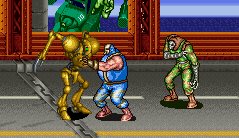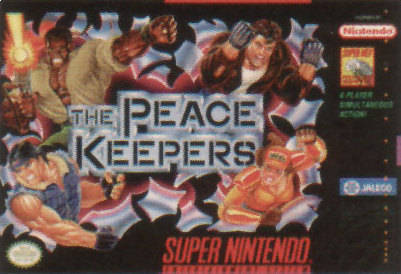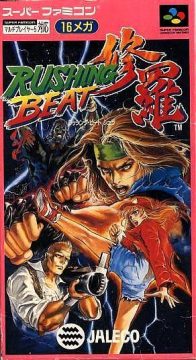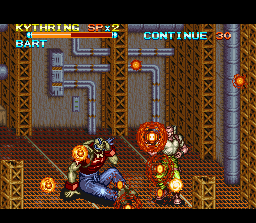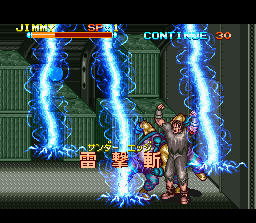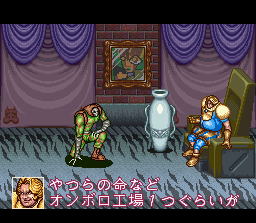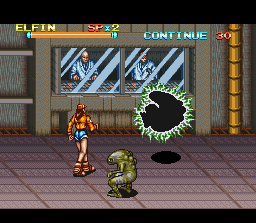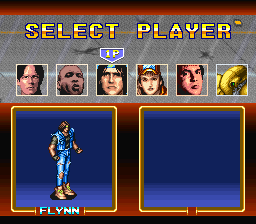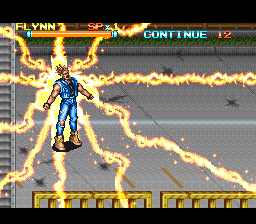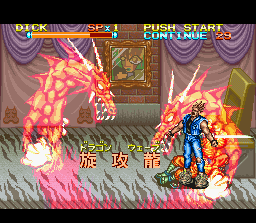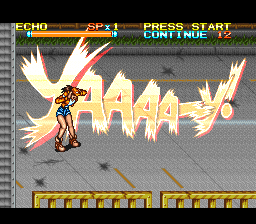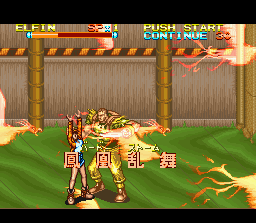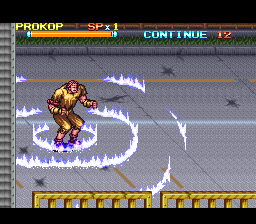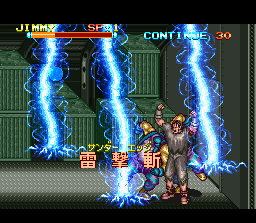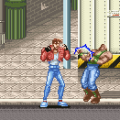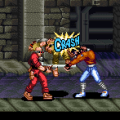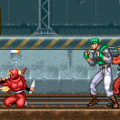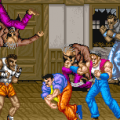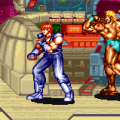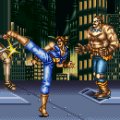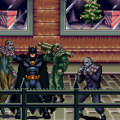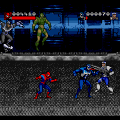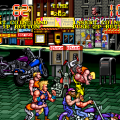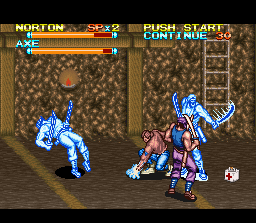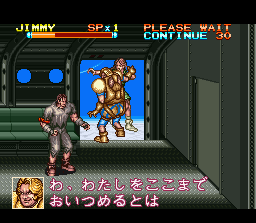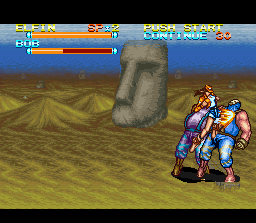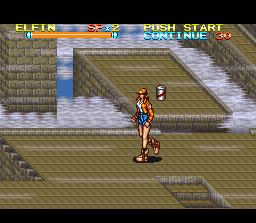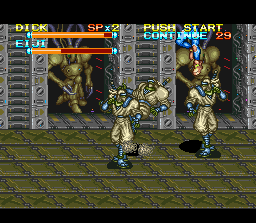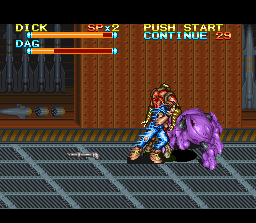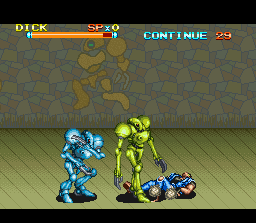- Rival Turf!
- Brawl Brothers
- Peace Keepers, The
The third installment, Rushing Beat Shura, is a curious entity that has more dimension and sustainability than your run-of-the-mill brawler. Depending on whether you play the original or the American version, The Peace Keepers, it is either arguably the best game of the series, or a rather bizarre and off-kilter game that, while still more remarkable than Rival Turf!, doesn’t quite seem up to the level of Brawl Brothers.
Seemingly unrelated to the plot of the previous two games at first glance, four all-new heroes are available for play at the offset:
Characters
Norton
If you take the right paths in the course of the game (or input a code on the title screen), there are actually two more available characters, with one being series all-timer Rick Norton. Douglas Bild even makes a cameo in the first stage if you know where to look, but he sits out from the main action.
There’s much more emphasis on the story this time around, and while nothing mindblowing, it appears to be a decently crafted narrative that has more thought put into it than your standard action game. The backstory ties in the previous two games by explaining how the world was left in a dire state after the advent of “Jeecus,” a drug distributed by Kintark/Big Al, the big bad of the first game, and the “Cyber Clone” invasion helmed by Iceman/Dieter, the villain of the second game. The DM corporation (Douglas Motor in Japan, and the sillier Deutschland Moldavia in America) provides advanced technology and medicine to help the world get back on its feet. Naturally, DM becomes so revered that they also gain a massive amount of political power, and its supremely evil leader, Kulmbach Lawrencium, uses DM’s resources to take over the world. Dick’s father, Harry, is murdered by DM agents, and so is Barkley, Elfin’s grandfather. Kythring’s military unit conducts recon, but one of the soldiers, Bart, is made a bloodthirsty semi-human, prompting his brother, McCoy, to go AWOL. Jimmy’s younger sister, Amy, is kidnapped by unscrupulous DM scientists, and Norton’s sister, Maria, is held prisoner by Kulmbach himself. A few researchers on the inside are disgusted at DM’s perverse experiments, so they reprogram one of DM’s M-Frame security robots to join the heroes and fight the many thugs working for the ominous conglomerate.
That’s quite a bit of text to digest, but it’s all relatively easy to follow. The main point is that the stakes are higher and the motivation to kick butt is weightier this time around. The overall feel is much darker than the previous two games, and there’s a somewhat consistent modern industrial theme in most stage designs, with some future technology thrown in for good measure. There’s the occasional bit of weirdness, like the ring match against tag-team wrestlers and the Japanese dojo level, but Rushing Beat Shura is generally more sure of its tone than its predecessors. The graphics, while darker than the previous two games, are the best in the series, with larger, more detailed, and better animated sprites than ever before. Each area has a unique feel to it ranging from factories to airports, waterfalls to abandoned hospitals, caves to a bizarre technological fortress that springs up in the middle of a desert island, and so forth. Some areas are so big that the screen vertically scrolls as you move, and hazards like mines, pitfalls, and electrical floors are more abundant compared to Rushing Beat Ran. While not the most gorgeous game on the Super Nintendo, the unique feel brought about by the visual style is one of Rushing Beat Shura‘s greater aspects. The locales are complimented by a great musical score that’s as energetic as it is dramatic. The boss theme particularly compliments the sense of danger you face against the game’s bigger baddies.
The gameplay is even further refined to make the action tough but fair. The pace is perhaps a bit slower than RBR, but enemies are generally less cheap, and your heroes can actually take a lot of punishment before folding. This increased lifebar is just as well, since you only have one life per continue, but this is compensated by giving you a crapload of continues; thirty, to be exact. Everyone has the standard arsenal: Basic combos, jump attacks, dash attacks, throws, special attacks, and good old Ikari mode, which REALLY causes enemies to fly when thrown. Weapons can also be found, mostly to be thrown (the rocks do a surprisingly high amount of damage if you bean someone with them), and health items can be carried with you as in RBR so long as you don’t use your character’s standard combo.
Everyone can taunt with the X button; while seemingly silly, pressing the A button while taunting causes your character to flip out and perform a “Termination Attack,” an impressive display of energy (often manifesting itself as some sort of beast like a dragon or a tiger) that wipes the screen of all enemies. You only get two per continue, so they’re only for the utmost times of desperation. Furthermore, each character has a special attack lending to their unique playstyles. Dick has the most interesting where he literally goes “Super Saiyan” and enters an invincible fury mode (different from Ikari mode) where his punches do massive damage. Elfin can double jump and perform a flaming knee drop, and Kythring can actually put that bazooka of his to good use. Jimmy can carry and shake any opponent he grabs six times before tossing them away, Norton actually activates Ikari mode for his Termination Attack, and M-Frame can shoot bullets out of its hands. It’s impressive enough to have six characters to pick in a brawler, much more so when each has a special technique that no one else contains. Naturally, this game is at its best when you have two players slamming around DM’s hired goons, and the generous amount of continues makes it easy enough for most tandem players to make it to the end.
The enemies this time around consist of weird skull-masked cannon fodder with claws, fat guys who attempt to grab you at every chance they get, spider-esque robots who scuttle along the ground and shock you, short mutants with Giger-esque long tongues, pirates with dual swords, obnoxiously agile street punks, and the obligatory ninjas. The most varied and interesting range of enemies in the series is also backed by a LOT of bosses, fourteen big battles overall. However, there is admitted laziness with several bosses reusing normal enemy sprites, like the pirates actually being used for TWO separate boss battles. This cut-and-paste job is probably the only annoying aspect of the otherwise fine graphics, but at least the bosses have new moves compared to their “regular forms” that make them pretty challenging.
However, you will not be able to fight every boss in a single playthrough, as Rushing Beat Shura actually has several different branching paths that lend to quite a bit of replay value! The first choice comes very early in the first level, where you either go up to face the mutant soldier Bart, or head forward to face his brother, the delirious McCoy. Some stages have secret rooms (including a particularly tough-to-see exit in the sewers which unlocks Norton for you early on), and the path you take determines whether your character earns a good ending or a not-so-good ending. Each character has different criteria for their better ending; Elfin takes the most effort for hers, as you have to find several captured scientists throughout the course of the best possible path, which requires you to accomplish the VERY tough feat of destroying two durable computers in fifteen seconds to prevent a plane crash in the airport level.
The multiple pathways, in addition to the best gameplay and appearance, make Rushing Beat Shura the finest of the trilogy and a great note upon which to end it. It also has the versus mode, which is still mostly a curiosity alongside the main game. However, it is notable for allowing four-player support, one of the rare uses for the four-player adapter outside of Super Bomberman. There’s even an awesome color edit mode in the options menu which allows you to alter the color palette of any sprite, much like several home releases of SNK’s King of Fighters games. You even get to customize everyone’s names to be as ridiculous as you want! RBS is one of the best beat-em-ups on the SNES and, while not as easy to get into as Turtles in Time or Streets of Rage 2, it is absolutely recommended for fans of this cathartic long-forgotten action sub-genre.
Lamentably, when the game came overseas as The Peace Keepers, it lost quite a bit in the conversion process. In a strangely coincidental parallel to Streets of Rage 3 (often thought of as inferior to its overseas counterpart, Bare Knuckle 3), the third game of a beat-em-up trilogy once again turns out to be the unfortunate victim of inexplicable butchering in the localization process. Unlike Brawl Brothers, its stages have not been changed around, so the full game structure is more or less still there. What is NOT there is the music. For some lamebrained reason, the localizers felt the music was obnoxious, unfitting, or otherwise unnecessary. If not a classic, it is at least the best OST of the series and actually adds a lot to the game’s atmosphere. That gets thrown out the porthole in the American version, where all music is replaced with ambiance by default. In some situations, the mere hush of background noise is enough and perhaps preferable, but not for a hypercharged beat-the-crap-out-of-all-enemies fightfest. The noise is actually fairly grating on the ears, particularly compared to a more deliberately ambient game like Secret of Evermore. There is an option to switch to “BGM” mode, but more than half of the game’s OST has been cut out, with one of the less better tracks (the DM labs theme) standing in for most areas. It is inexplicable and inexcusable as to why the localizers would have changed the music around so drastically when there was absolutely nothing wrong with it in the first place.
The music removal is the most noticeable problem, but other factors have also been nerfed. The Peace Keepers is made more artificially difficult than Rushing Beat Shura by clipping down the number of continues from a plentiful thirty to a paltry twelve. RBS isn’t the toughest game around and can be beaten using less than twelve continues with enough practice, but its removal is still annoying. The story has also been massively dumbed down with translated dialogue that comes off as flat and stupid, and arbitrary pop culture references are thrown in that feel cheesy and out of place. For example, Kulmbach, now renamed “Trip Iago,” speaks in Shakespearean dialogue for no better reason than to sound dignified. Several stages are now named after media works like the classic war film “Stalag 17” and “Snake Plissken Ave.” in a nod to Escape from New York. The translators of the time may have thought this was amusing, but these random references just some off as embarrassing in retrospect. The in-between stage scenes with Kulmbach gloating have also been removed, and Maria Norton doesn’t even appear until after the last fight. As another downgrade, the originally drawn character portraits were replaced by digitized actors that mostly look ugly and tread a bit into the “uncanny valley” in terms of creepiness.
As in the two previous Rushing Beat translations, most hero and enemy names have been switched around like the aforementioned “Trip Iago.” The basic Dag enemies are now known as Fnords (a reference to the sci-fi Illuminatus! trilogy), soldiers McCoy and Bart are now Jesse and Connor, M-Frames are called Orbots and so on. Most of the new names aren’t all that stupid (though Trip Iago and Prokop are pretty bad, with no offense intended to the actual Mr. Prokop), but as with the previous two games, who knows why they were switched in the first place.
Ironically, this is the only American game where they left Norton’s name alone, and a couple of other characters (like hulking judoka Yamaoka) are the same in both versions. Unfortunately, the localizers removed the ability to change all the character names, but at least they didn’t boot the entire color edit mode. Still, it blows that you can’t revert any of the other characters’ names back to their originals if you would like to do so. If nothing else, the core game mechanics have been unaltered, though the spider robot enemies were removed for no adequately explored reason, and the animations for the Termination attacks look stupider; particularly embarrassing is how Elfin’s multi-firebird wave has been changed into Echo screaming really loud. The Peace Keepers is still technically playable (and has the least embarrassing American boxart), but it is a mere shadow of the game it once was. It is advised to import Rushing Beat Shura if possible, though the only caveat is that the plot is incomprehensible unless you can read Japanese characters. Still, a good albeit incomprehensible beat-em-up is better than an okay beat-em-up with a bad translation.
